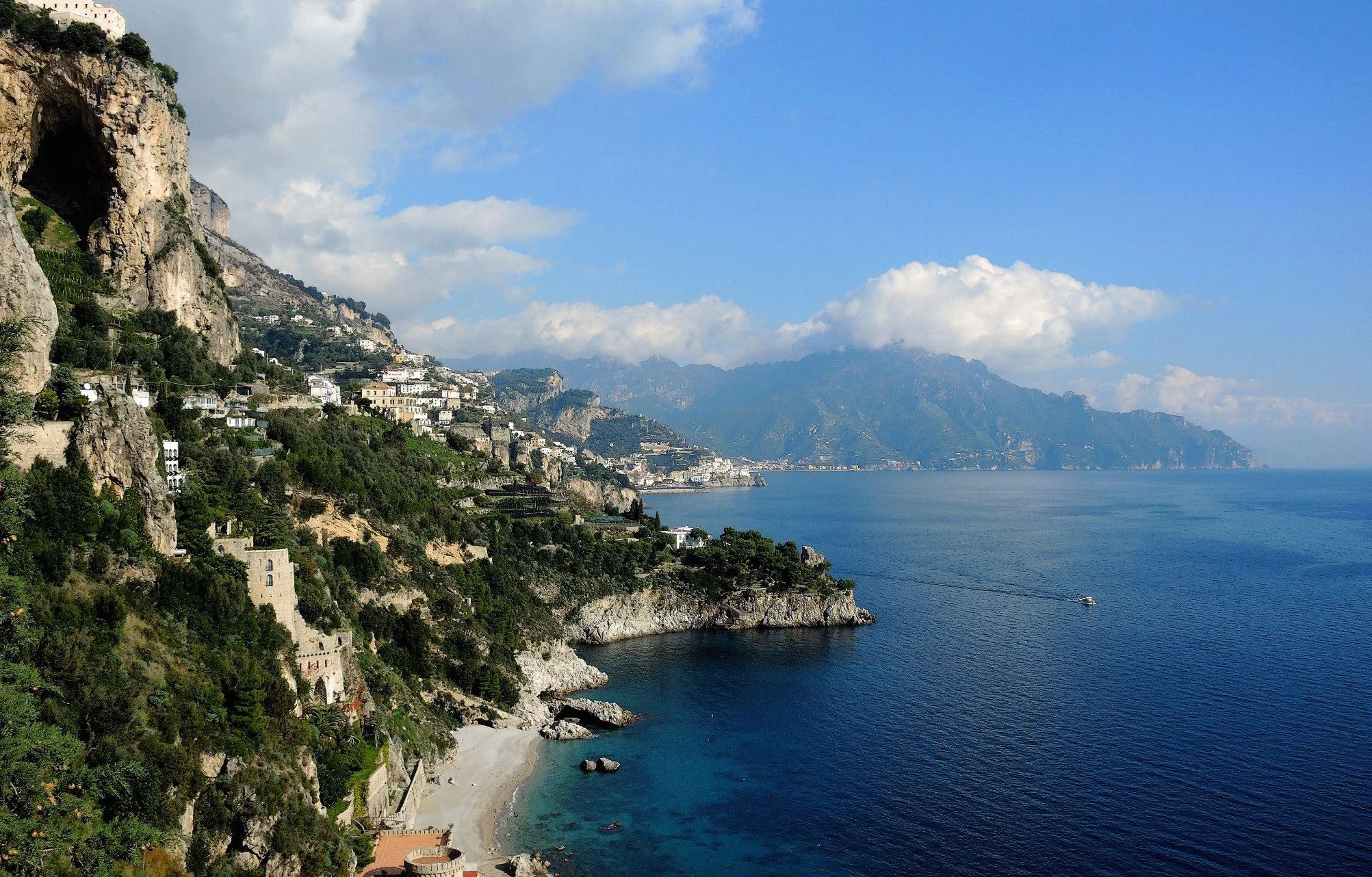All in Amalfi Coast Travel
It’s not Holy Thursday in Naples without Zuppa di Cozze Mussel Stew. While we may be abstaining for meat for several days in Napoli, that’s no reason to go hungry. Enjoy Sauced & Found’s recipe for authentic Neapolitan Zuppa di Cozze this year on Holy Thursday, the Thursday before Easter!
After a relatively ordinary career as a civil servant, I became an accidental farmer sometime in the winter of 2015. I went from preparing cumbersome briefing books for congressional hearings in Washington DC to planting rows of zucchini seedlings about 700 meters above sea level on the tippy top of the Amalfi Coast in a small village called Agerola. What started as a gingham dappled dream overflowing with Mason jars quickly became the Sisyphean reality of harvest, preserve, eat, repeat. At least the views were amazing. Now as the world seems to steadily embrace social distancing amidst the recent COVID-19 pandemic, I find a surprisingly familiar muscle memory of food preservation kicking back into gear.
It should come as no surprise that the Amalfi Coast and its neighboring islands are among the most spectacularly cinematographic locations in the world. Legendary directors including Roberto Rossellini and Federico Fellini adored filming here. Sophia Loren had a vacation home with Carlo Ponti here. Greta Garbo got married here! From Capri to Ravello and beyond, the Amalfi Coast is home to some of the most iconic scenes shot in the last century. They are uplifting to watch in their own right and if you are planning a trip to the region, these films certainly set the tone!
As the winter unfolds, there is nothing better than a good book. Except perhaps, dreams of the sun dappled cliffs of the Amalfi Coast. Throughout the 19th and 20th centuries, many important global literary figures including Gore Vidal and Henrik Ibsen lived and wrote in the region. Whether you are day dreaming or trip planning, the list below will capture your imagination. Get into the Amalfi Coast state of mind, reading the notable works below.
Check out the event highlights of the Amalfi Coast this September with the Sauced & Found Guide. From music to food to history, we have got you covered as the autumn creeps upon us.
Let me start by saying this: I love all my family so much. But we often argue on vacations. Yes, we are all adults here. But since my brother and I moved out (and honestly, even before that because who am I kidding), family vacations can quickly become deep-seated arguments if we’re not careful. Here are my top tips for a successful family trip!
One of the cool things I was able to witness was a professional chef make a traditional Italian dish for a wedding. Now, the way people prepare a meal here seems to be different from the States. Here, you will add different ingredients until you decide it’s enough. Where in the States, you follow a recipe to the exact measurements. Don’t get confused, these recipes do have some measurements, but they are more like a suggestion and you decide what you would like to do instead.
If you ask any Neapolitan about Conca dei Marini, they will enthusiastically tell you that the sfogliatella pastry was invented there. Like many pastries of the middle ages, cloistered nuns invented the sfogliatella. It seems that while the cloistered men made alcoholic tinctures to maintain their independent cash flow, their sisters of the cloth were busy making sweet treats. And so was the case of the sfogliatella. The Santa Rosa Convent soaring above the tiny port of Conca dei Marini is where the ricotta stuffed and amarena cherry studded shell shaped pastry was born.
Furore is perhaps the most logic defying of any town on the Amalfi Coast. It is a vertical sliver of land that runs from the deep crevice of the Fiordo port on the sea to about 600 meters above sea level high into the Monti Lattari Mountains. There is no central piazza. No easy road to connect lower and upper Furore. The people of Furore even have split identities with those in the upper quarters more closely identifying with the mountain dwellers of Agerola and the lower quarters more historically linked to the mariners of nearby Conca dei Marini.
Praiano gets her name from the Latin word pelagium, meaning open sea. Later the same word would evolve to mean beach in both Spanish (playa) and Portuguese (praia). Praiano consists of two main parts. Vettica Maggiore which lies lower on the coast and Praino on the upper part of this vertical town. The main road SS 163 Amalfitana slices through the two neighborhoods. Nobles throughout the days of the Amalfi Republic summered here and today you can affordably rent family villas in Praiano with dazzling sea views.
Positano defies gravity. Pastel buildings hang like tendrils dipping over the sea. Mosaic church domes are wedged between cliffs. Old ladies with in matching house dresses and droopy nylons trudge up countless stairs. The town is vertical, funneling from a long, winding strip of coast into the hills. The highest neighborhood of Positano is Montepertuso, meaning Mount Hole in local dialect. As the legend goes, villagers attempting to escape marauders scampered into the hills above town only to become blocked by an imposing rock formation. They prayed to the Virgin Mary and so she ventured down from the heavens and parted the rocks, allowing the early Positanese to pass through safely. The hole in this rock formation is said to resemble the Madonna (I think it looks like an rather beaky eagle) and would give Montepertuso its name.
The Amalfi Coast offers some of the most striking panoramic vistas in the world. I like to call it suffocatingly beautiful because everywhere you look, every jagged cliff, every bougainvillea encrusted villa, every secret stone tipping into the sea is simply more beautiful than the last thing you saw not just that day but in your life. Driving down the Amalfi Coast is the pastel panoramic equivalent of gavaging yourself with shrooms at Woodstock. You just do not, cannot believe that what you are seeing is real. The good news is that it most definitely is.
Most of the visitors to our little region of Italy, technically referred to as the Region of Campania, blow through Naples on their way to the Amalfi Coast. The Region of Campania actually consists of five provinces Naples, Salerno, Avellino, Caserta and Benevento. The Amalfi Coast is in the Province of Salerno. The Gulf of Sorrento and Capri are in the Province of Naples. It is important to remember that culturally, historically, geographically and even linguistically and culinarily the Amalfi Coast and the Gulf of Sorrento are two distinct regions. Many like to think of Sorrento as the gateway to the Amalfi Coast. Fair enough, it is certainly a convenient and less expensive place to stay and use as a home base when exploring the towns of the Amalfi Coast.
So many foods to sample in this most spectacular region of the world. While the views alone are worth the trip- it is the food that makes you yearn to return.
Let me tell you a little story about my first journey to the Amalfi Coast. My friend met me in Rome. Easy enough. We stayed two nights. Did our thing- Spanish Steps, Vatican, Trastevere. Drank too much Frascati, woke up one morning hungover and it was time to take the train to Naples and continue onward to the Amalfi Coast. Feeling plucky, we decided to take the Freccia Rossa high speed train. We had tramezzini sandwiches and little bottles of prosecco to wag a hair out of the dog or whatever it is they say about drinking more alcohol to cure drinking too much of it. In spite of the fact that we seemed to be approaching our upcoming holiday with the same mental fortitude as a harem of spring breakers in Panama City, I was feeling pretty good about how the day was going.
Let’s get one thing straight. This list is by no means exhaustive. You could eat for years on the Amalfi Coast and still have not tried every plate the region has to offer. Many of the same dishes are found in the the Gulf of Sorrento, Capri and the Phlegrean Islands. I have tried to limit this top ten list to foods that are strictly native to this wondrous stretch of coast and have stories linked to specific towns. Sfogliatella, for example, was invented in the Amalfi Coast town of Conca dei Marini. Parmigiana di Melanzane (Eggplant Parmesan), on the other hand is ubiquitous throughout all of Southern Italy and is a true staple of the Southern Mediterranean summer diet. To understand the foods typical to the Amalfi Coast, one must observe the region’s topography.
Rossellini was correct. The people here are crazy. They also know how to live. And the beaches prove it. After years living on the Amalfi Coast, I have learned a few things about beach going here to make things a little less crazy.
First, there is a different between a private and public beach. Stablimenti or beach clubs require you to pay anywhere from 5-10 Euro for a beach chair on their part of beach. Spiggie libere, or free beaches allow you to spread out your towel, picnic and do as your heart’s content. Often the people on the free beaches can be a bit on the vulgar side. These beaches attract large families from the provinces who seem to colonize with umbrellas, picnic tables, sports equipment. You would think they were prepared to head west on the Oregon Trail with all of the equipment they have. Unsurprisingly, I don’t particularly enjoy these beaches. From time to time, I may spread out a towel and enjoy a panino on a free beach. However, if you are on vacation on the Amalfi Coast- be civilized and treat yourself to a lettino. Otherwise you may end up with an errant beach ball to the head and screechy nonna telling you to move your beach towel over because you are in her spot! There is not such thing as a free beach when a nonna from the provincial hinerlands of Pagani is bellowing at you...
















